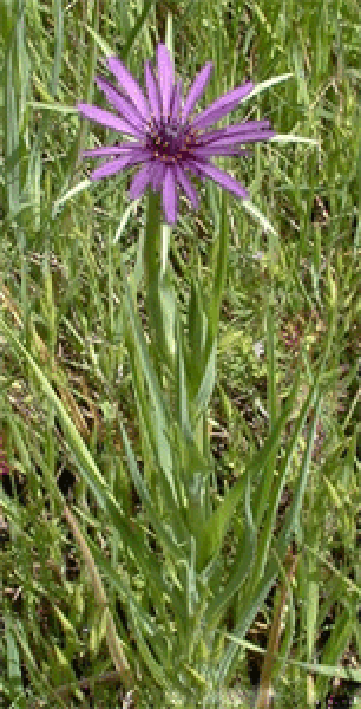 Purple salsify plant in flower.
Purple salsify plant in flower.
Welcome to the summary page for FabulousFusionFood's Cook's Guide entry for Salsify (Purple) along with all the Salsify (Purple) containing recipes presented on this site, with 4 recipes in total.
This is a continuation of an entire series of pages that will, I hope, allow my visitors to better navigate this site. As well as displaying recipes by name, country and region of origin I am now planning a whole series of pages where recipes can be located by meal type and main ingredient. This page gives a listing of all the Salsify (Purple) recipes added to this site.
These recipes, all contain Salsify (Purple) as a major wild food ingredient.
Purple Salsify (Tragopogon porrifolius), also known as Oyster Plant, Vegetable Oyster, Goatsbeard or Salsify and Common Salsify. It is a common wildflower, originally native to the Mediterranean but now introduced to northern Europe, North America and southern Africa. It has grass-like leave and grows to about 60cm high The flower head is about 5cm across, and each is surrounded by green bracts which are longer than the petals.
The roots (and the young shoots) of purple salsify are used as a vegetable, and historically the plant was cultivated for that purpose; it is mentioned by classical authors such as Pliny the Elder. However in modern times it has tended to be replaced by Spanish Salsify or Black Salsify as a cultivated crop. The plant's alternate names derive from the flavour of the root which is said to taste rather like oysters. The roots of young plants can be grated for inclusion in salads, but older roots are better cooked, and they are usually used in soups or stews. The flowering shoots are also edible and can be used like asparagus, either raw or cooked. The flowers also make a colourful addition to a salad and the sprouting seeds an also be used in salads or as a topping to sandwiches.
The whole herb possesses a pleasant taste and flavour, the green parts having a similar aromatic character to the flowers, leading to the use of the plant to strew on floors to give the rooms a pleasant aroma, and its use to flavour wine and beer. In the past the root was dried, ground and used as a substitute for flour. The plant can also be roast as a vegetable.
This is a continuation of an entire series of pages that will, I hope, allow my visitors to better navigate this site. As well as displaying recipes by name, country and region of origin I am now planning a whole series of pages where recipes can be located by meal type and main ingredient. This page gives a listing of all the Salsify (Purple) recipes added to this site.
These recipes, all contain Salsify (Purple) as a major wild food ingredient.
Purple Salsify (Tragopogon porrifolius), also known as Oyster Plant, Vegetable Oyster, Goatsbeard or Salsify and Common Salsify. It is a common wildflower, originally native to the Mediterranean but now introduced to northern Europe, North America and southern Africa. It has grass-like leave and grows to about 60cm high The flower head is about 5cm across, and each is surrounded by green bracts which are longer than the petals.
The roots (and the young shoots) of purple salsify are used as a vegetable, and historically the plant was cultivated for that purpose; it is mentioned by classical authors such as Pliny the Elder. However in modern times it has tended to be replaced by Spanish Salsify or Black Salsify as a cultivated crop. The plant's alternate names derive from the flavour of the root which is said to taste rather like oysters. The roots of young plants can be grated for inclusion in salads, but older roots are better cooked, and they are usually used in soups or stews. The flowering shoots are also edible and can be used like asparagus, either raw or cooked. The flowers also make a colourful addition to a salad and the sprouting seeds an also be used in salads or as a topping to sandwiches.
The whole herb possesses a pleasant taste and flavour, the green parts having a similar aromatic character to the flowers, leading to the use of the plant to strew on floors to give the rooms a pleasant aroma, and its use to flavour wine and beer. In the past the root was dried, ground and used as a substitute for flour. The plant can also be roast as a vegetable.
The alphabetical list of all Salsify (Purple) recipes on this site follows, (limited to 100 recipes per page). There are 4 recipes in total:
Page 1 of 1
| Baked Salsify Origin: Britain | Salsify Fritters Origin: Britain |
| Cream of Salsify Soup Origin: Britain | Salsify with Cheese Origin: Britain |
Page 1 of 1